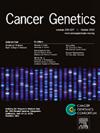METTL3-mediated m6A modification of pri-miR-93 promotes hepatocellular carcinoma progression via CDKN1A suppression
IF 2.1
4区 医学
Q4 GENETICS & HEREDITY
引用次数: 0
Abstract
N6-methyladenosine (m6A) is the most common RNA modification in eukaryotic transcriptomes and plays a key role in various biological processes. However, its function in disease, particularly in microRNA regulation, remains unclear. Hepatocellular carcinoma (HCC) is a major global health challenge, with high morbidity and mortality rates. Investigating the role of m6A modification in HCC may provide valuable insights into its molecular mechanisms.
This study found that METTL3, an m6A methyltransferase, is significantly upregulated in HCC and is associated with poor prognosis. Bioinformatics analysis of the GSE37001 dataset showed that silencing METTL3 in HepG2 cells suppressed cell cycle-related pathways. Among several candidate miRNAs potentially regulated by METTL3 in an m6A-dependent manner, miR-93–5p was selected for further study. Experimental results demonstrated that METTL3-mediated m6A modification promotes miR-93–5p expression by facilitating pri-miR-93 processing. Functional assays confirmed that miR-93–5p directly targets CDKN1A and downregulates its expression. Moreover, METTL3 overexpression rescued the effects of METTL3 knockdown on pri-miR-93 m6A levels and miR-93–5p expression. Rescue experiments further showed that METTL3 promotes HCC cell proliferation and cell cycle progression while inhibiting apoptosis via the miR-93–5p/CDKN1A axis.
In summary, METTL3 is highly expressed in HCC and contributes to tumor progression by promoting miR-93–5p expression through m6A modification, thereby suppressing CDKN1A. These findings highlight a potential regulatory mechanism in HCC and suggest that targeting the METTL3/miR-93–5p/CDKN1A axis could be a novel therapeutic strategy.
mettl3介导的m6A修饰pri-miR-93通过抑制CDKN1A促进肝细胞癌的进展
n6 -甲基腺苷(m6A)是真核生物转录组中最常见的RNA修饰,在各种生物过程中起着关键作用。然而,其在疾病中的功能,特别是在microRNA调控中的功能尚不清楚。肝细胞癌(HCC)是一个主要的全球健康挑战,具有高发病率和死亡率。研究m6A修饰在HCC中的作用可能为其分子机制提供有价值的见解。本研究发现,m6A甲基转移酶METTL3在HCC中显著上调,并与不良预后相关。GSE37001数据集的生物信息学分析表明,沉默HepG2细胞中的METTL3抑制了细胞周期相关通路。在METTL3可能以依赖m6a的方式调控的几个候选mirna中,miR-93-5p被选中进行进一步研究。实验结果表明,mettl3介导的m6A修饰通过促进pri-miR-93加工来促进miR-93-5p的表达。功能分析证实miR-93-5p直接靶向CDKN1A并下调其表达。此外,METTL3过表达挽救了METTL3敲低对pri-miR-93 m6A水平和miR-93-5p表达的影响。救援实验进一步表明,METTL3通过miR-93-5p /CDKN1A轴促进HCC细胞增殖和细胞周期进展,同时抑制细胞凋亡。综上所述,METTL3在HCC中高表达,通过m6A修饰促进miR-93-5p表达,从而抑制CDKN1A,从而促进肿瘤进展。这些发现强调了HCC的潜在调控机制,并表明靶向METTL3/ miR-93-5p /CDKN1A轴可能是一种新的治疗策略。
本文章由计算机程序翻译,如有差异,请以英文原文为准。
求助全文
约1分钟内获得全文
求助全文
来源期刊

Cancer Genetics
ONCOLOGY-GENETICS & HEREDITY
CiteScore
3.20
自引率
5.30%
发文量
167
审稿时长
27 days
期刊介绍:
The aim of Cancer Genetics is to publish high quality scientific papers on the cellular, genetic and molecular aspects of cancer, including cancer predisposition and clinical diagnostic applications. Specific areas of interest include descriptions of new chromosomal, molecular or epigenetic alterations in benign and malignant diseases; novel laboratory approaches for identification and characterization of chromosomal rearrangements or genomic alterations in cancer cells; correlation of genetic changes with pathology and clinical presentation; and the molecular genetics of cancer predisposition. To reach a basic science and clinical multidisciplinary audience, we welcome original full-length articles, reviews, meeting summaries, brief reports, and letters to the editor.
 求助内容:
求助内容: 应助结果提醒方式:
应助结果提醒方式:


